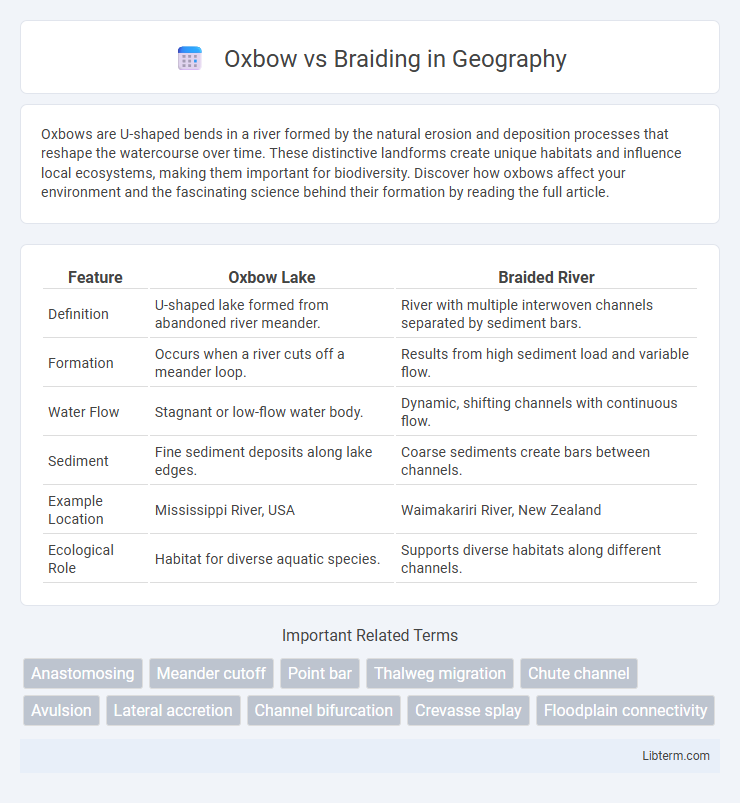Oxbows are U-shaped bends in a river formed by the natural erosion and deposition processes that reshape the watercourse over time. These distinctive landforms create unique habitats and influence local ecosystems, making them important for biodiversity. Discover how oxbows affect your environment and the fascinating science behind their formation by reading the full article.
Table of Comparison
| Feature | Oxbow Lake | Braided River |
|---|---|---|
| Definition | U-shaped lake formed from abandoned river meander. | River with multiple interwoven channels separated by sediment bars. |
| Formation | Occurs when a river cuts off a meander loop. | Results from high sediment load and variable flow. |
| Water Flow | Stagnant or low-flow water body. | Dynamic, shifting channels with continuous flow. |
| Sediment | Fine sediment deposits along lake edges. | Coarse sediments create bars between channels. |
| Example Location | Mississippi River, USA | Waimakariri River, New Zealand |
| Ecological Role | Habitat for diverse aquatic species. | Supports diverse habitats along different channels. |
Introduction to Oxbow and Braiding
Oxbow formations occur when a river creates pronounced meanders that eventually become cut off from the main channel, forming distinct crescent-shaped lakes. Braiding refers to a river pattern characterized by multiple interweaving channels separated by small, sediment-rich islands known as braid bars. These fluvial processes highlight different sediment deposition and flow dynamics, crucial for understanding river morphology and aquatic habitats.
Definition of Oxbow Lakes
Oxbow lakes form when a wide meander from the main stem of a river is cut off, creating a free-standing body of water shaped like a crescent or horseshoe. This geological feature results from the natural process of erosion and deposition along riverbanks, where sediment buildup eventually seals off the meander bend from the flowing river. In contrast, braiding refers to a network of river channels separated by small, often temporary, sediment bars, demonstrating significantly different fluvial dynamics and sediment transport.
Understanding Braided Rivers
Braided rivers consist of multiple interwoven channels separated by temporary sediment bars, forming intricate networks due to variable water flow and abundant sediment supply. These rivers often develop in areas with steep gradients and high sediment loads, causing frequent channel shifts and dynamic habitats. Understanding braided rivers is essential for managing sediment transport, flood risks, and ecological diversity in riverine environments.
Formation Processes: Oxbow vs Braiding
Oxbow lakes form through the gradual meandering and erosion of riverbanks, where sediment deposition isolates a river bend into a separate, crescent-shaped water body. Braided rivers develop when high sediment loads and variable water flow cause the channel to split into multiple intertwining channels separated by transient sediment bars. The contrasting formation processes highlight how oxbows result from lateral river migration in stable flow conditions, while braiding emerges from unstable flows and abundant sediment deposition.
Key Geographical Differences
Oxbows form in low-gradient, meandering rivers where sediment deposition causes river channels to cut off loops, creating isolated water bodies typically found in floodplains. Braiding occurs in rivers with high sediment loads and variable discharge, often in mountainous or glacial regions, resulting in multiple interwoven channels separated by unstable bars. The key geographical difference lies in oxbows developing in mature river landscapes with gentle slopes, while braids dominate in steep, sediment-rich environments with dynamic flow conditions.
Sediment Deposition Patterns
Oxbow lakes form as a result of sediment deposition narrowing the meander neck, eventually isolating a segment of the river channel and creating a crescent-shaped lake. In contrast, braiding channels exhibit dynamic sediment deposition patterns with multiple interwoven channels separated by transient sediment bars composed of sand and gravel. The sediment distribution in braiding systems is highly variable, driven by fluctuating flow and sediment load, whereas oxbow lakes represent stable sediment accumulation zones that alter floodplain morphology.
Ecological Impacts and Biodiversity
Oxbow lakes and braiding river systems play distinct roles in shaping ecological impacts and biodiversity. Oxbow lakes, formed by the cutoff of meanders, create isolated wetland habitats that support diverse aquatic species, amphibians, and waterfowl, enhancing local biodiversity through stabilized nutrient cycling and sheltered breeding grounds. Braided rivers, characterized by multiple shifting channels and sediment bars, foster high habitat heterogeneity and dynamic ecological niches, supporting a broad range of invertebrates, fish species adapted to fluctuating conditions, and riparian vegetation, which together contribute to greater landscape-level biodiversity and ecological resilience.
Human Influence and Management
Oxbow lakes form through natural river meandering processes but are often influenced by human activities such as dam construction and land-use changes that alter sediment flow and water dynamics. Braiding rivers, characterized by multiple interwoven channels, are significantly affected by human management practices including channel dredging, flood control measures, and vegetation removal that modify sediment distribution and flow patterns. Effective management of both oxbow and braided river systems requires balancing ecological preservation with flood mitigation and infrastructure development goals.
Notable Examples Around the World
The Oxbow phenomenon is vividly illustrated by the U-shaped cutoffs of the Mississippi River in the United States and the Thames River in London, showcasing natural river evolution through meander abandonment. Braiding is prominently seen in the Brahmaputra River of India and Bangladesh, where multiple interweaving channels create dynamic, sediment-rich waterways prone to rapid changes. These examples highlight the distinct hydraulic and sediment transport processes shaping fluvial landscapes globally.
Conclusion: Oxbow vs Braiding
Oxbow streams form when a meander is cut off from the main river channel, creating a distinct U-shaped water body, while braiding occurs in rivers with high sediment loads and variable flow, resulting in multiple interconnected channels. Oxbow lakes indicate stable channel migration and floodplain development, whereas braided rivers reflect dynamic sediment transport and channel instability. Understanding these formations helps in predicting river behavior, managing flood risks, and preserving aquatic habitats.
Oxbow Infographic

 libterm.com
libterm.com